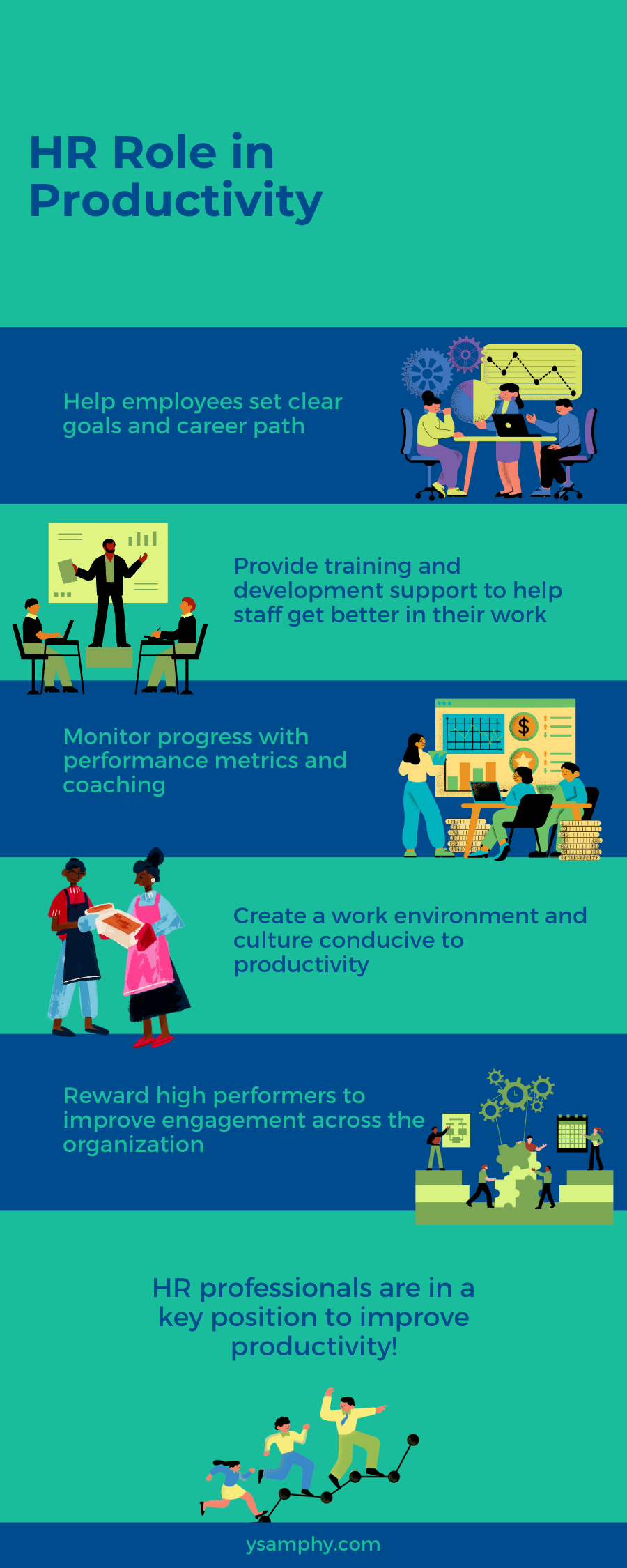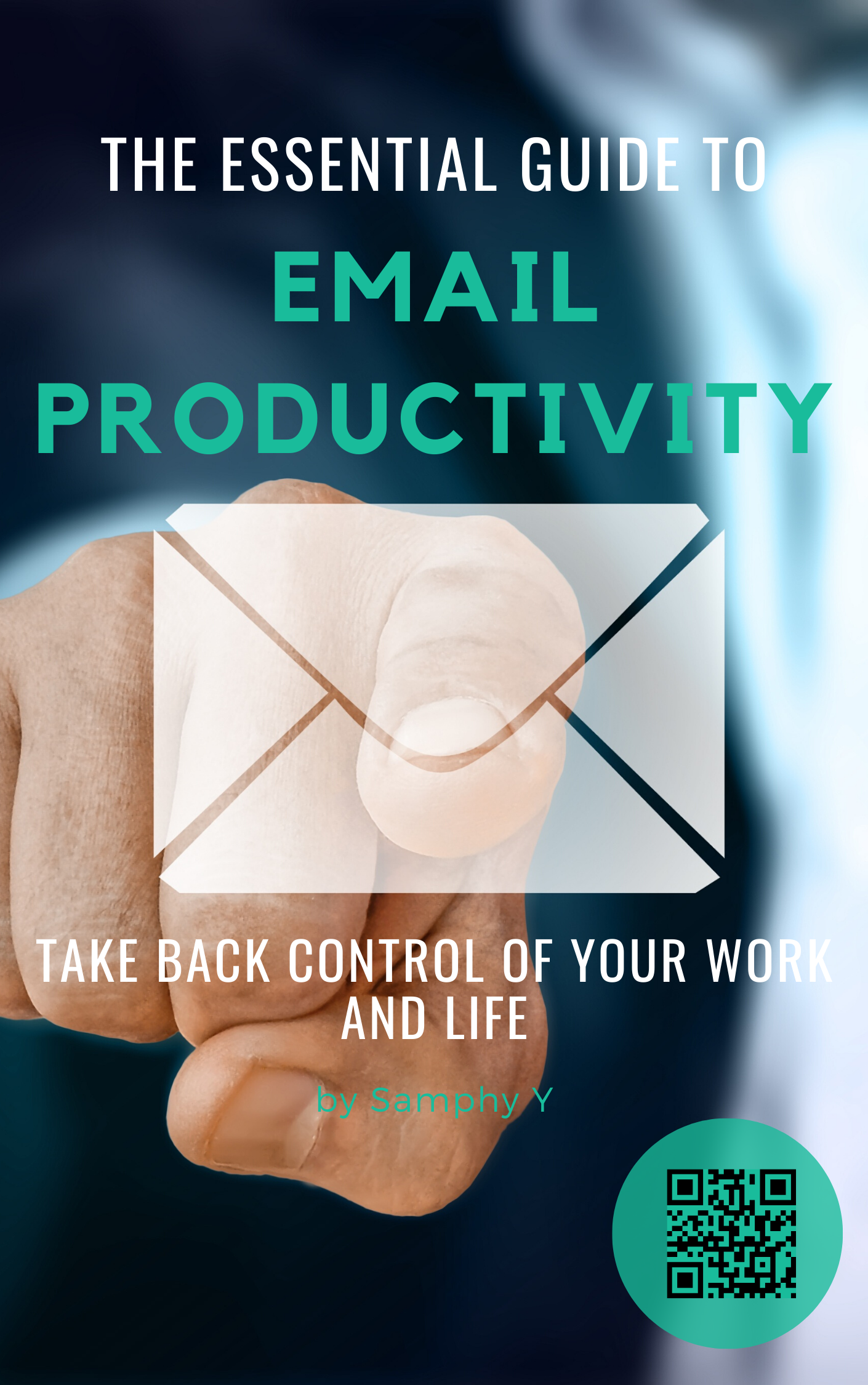How can HR improve productivity? This question is of utmost importance to knowledge workers and organizations looking to enhance their performance. In this blog post, we will delve into the various strategies that HR professionals can implement to ensure a highly productive workforce.
We'll explore the significance of hiring the right people and establishing clear employee goals. We'll also discuss how providing training opportunities and resources can further bolster employee productivity. Monitoring progress and creating a positive work environment are also essential components in our discussion on improving organizational performance.
Lastly, fostering innovation and measuring results will be critical factors driving productivity improvements. HR departments can keep morale high by recognizing and awarding personnel for their efforts. Stay tuned as we uncover valuable insights on how HR leaders can effectively optimize employee productivity.
How can HR improve productivity for business? Check out our latest blog post on how HR can implement effective strategies to boost productivity and achieve success! #HR #productivity #success"
Understand the Role of HR in Productivity
Human Resources (HR) plays a vital role in improving productivity. HR professionals are responsible for setting clear goals and objectives, providing resources and support, monitoring progress, creating a positive work environment, encouraging innovation, measuring results, and recognizing employees who perform well.
By automating these processes with human resource management software, HR teams dedicate more time to strategic initiatives, talent development, and fostering a positive workplace culture. This automation significantly reduces the time and effort required for administrative tasks compared to manual methods, allowing HR professionals to focus on more value-added activities. Additionally, the implementation of such software not only increases efficiency but also contributes to better employee engagement, ensuring that organizations can thrive in the competitive market. The stark contrast between manual and software-driven HR processes underscores the transformative impact of HR management software on streamlining operations and enhancing overall productivity.
Regarding goal-setting, HR must ensure that the company's objectives are clearly communicated to all staff members. This can be done through effective communication strategies such as regular team meetings or individual performance reviews. Additionally, HR should provide resources such as training programs or access to external experts that will help employees reach their goals more efficiently.
Providing support is another key factor in driving productivity. Employees must feel supported by their supervisors and peers to foster a productive work environment. HR can facilitate this process by promoting open dialogue between management and staff members so everyone feels heard and valued at work. With comprehensive HR Consultancy services, HR teams can also provide employees with the necessary guidance and support to navigate any work-related challenges they may face. This support can also involve implementing policies and procedures to address any workplace issues, ensuring a harmonious working environment.
Monitoring progress is essential for tracking how well employees are meeting their targets. This could involve periodic performance evaluations or tracking metrics such as output per hour worked or customer satisfaction ratings over time. By doing so, HR can identify areas where improvements need to be made in order for the organization’s overall productivity levels to increase significantly over time.
Creating a positive work environment is also important for boosting employee morale and motivation levels, which ultimately leads to higher productivity rates among workers. To achieve this, employers should strive towards implementing policies that promote collaboration amongst staff, offering flexible working arrangements where possible, encouraging healthy competition within teams, providing recognition for outstanding contributions from individuals, etc.
Encouraging innovation is another way HR departments can drive up workplace efficiency. Ideas from outside sources may prove invaluable when trying new approaches to tackling existing challenges an organization faces. Allowing experimentation with different processes while ensuring safety measures are taken into account helps foster creativity within an organization leading up to greater success.
Finally, measuring results provides valuable insights into how successful initiatives have been throughout any given time - allowing leaders across all departments to make informed decisions about future projects based on past data gathered during these measurement periods. From here on out, organizations can use this information to measure successes and failures, giving them an edge over competitors when looking ahead at potential opportunities available down the road.
Recognizing excellent performance from individual team members goes a long way towards boosting morale throughout any organization, resulting in improved overall engagement across all business units and increased productivity over time. Through incentives such as rewards programs, companies can show appreciation for hardworking individuals while motivating others around them to follow suit, thus ensuring no one gets left behind along the journey.
By understanding the role of HR in productivity, organizations can create an environment where employees are motivated and productive. Organizations can guarantee their teams' proficiency by employing the appropriate personnel for each position.
Key Takeaway
HR professionals are in a key position to improve productivity by setting clear goals, providing resources and support, monitoring progress, creating a positive work environment, and incentivizing excellence. By fostering innovation while measuring results, they can ensure their organization stays ahead of the curve with increased efficiency over time.
Hire the Right People
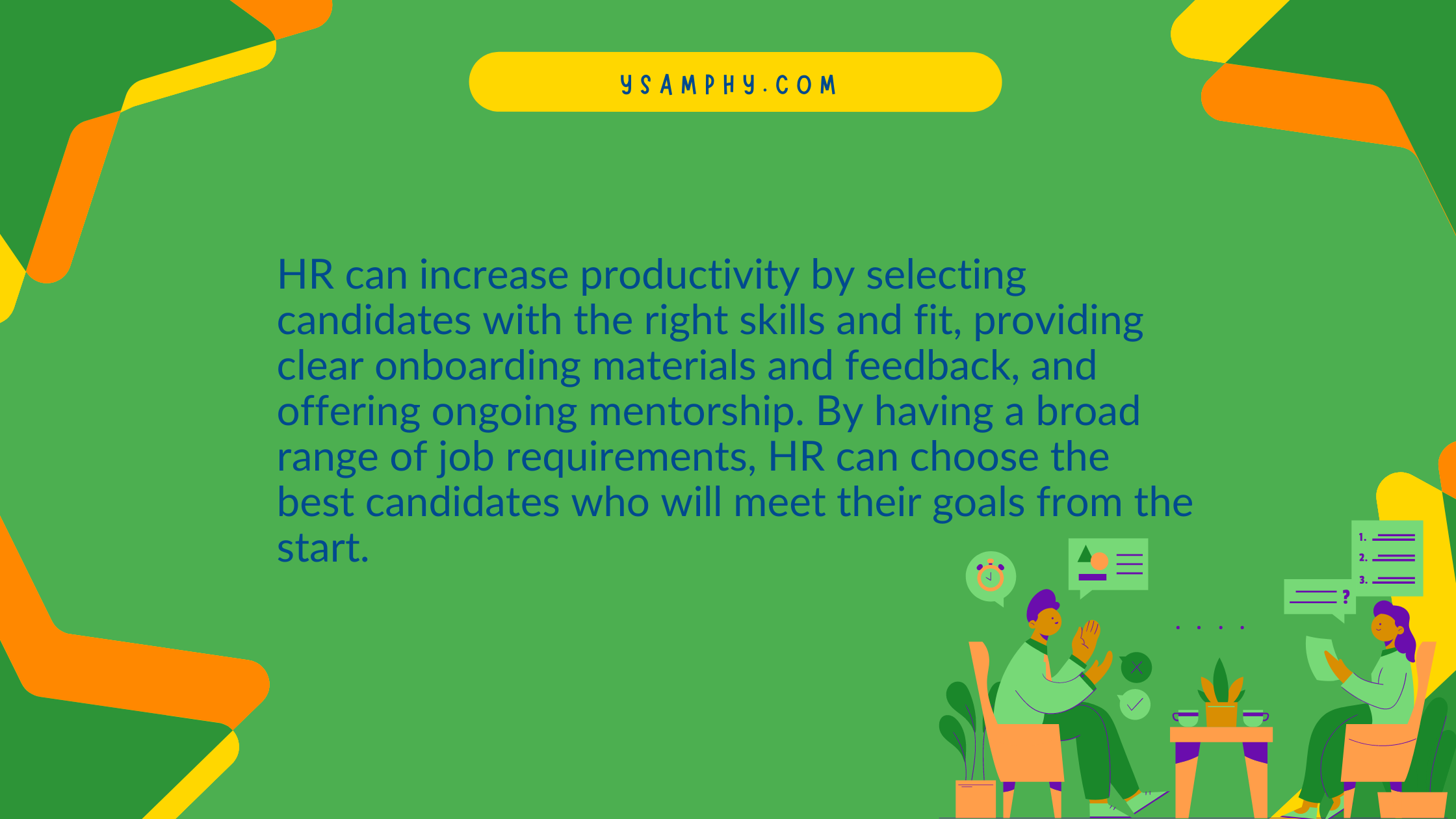
Hiring the right people is essential to increasing productivity. Identifying personnel who possess the right abilities and credentials for a specific job, as well as those that fit in with your organization's atmosphere, is crucial. Assessing applicants thoroughly during recruitment can help ensure you bring on board personnel who will benefit your organization.
When assessing potential hires, look at their previous work experience and education level. Ensure they possess all the technical skills needed for success in their position. Additionally, consider how well they might mesh with existing team dynamics and company values. An insight into a candidate's potential fit can be gained through inquiries that probe their behavior in diverse contexts and how they tackle challenges. If you are trying to find a transformative VP of Operations, a candidate with years of experience in managing large teams may be the right choice. However, if you are looking for someone to fill an entry-level position in retail sales, hiring an individual who has worked extensively as a server at a restaurant may prove beneficial.
It’s also important to make sure you have clear expectations when it comes to job roles and responsibilities so that new hires know what is expected from them on day one. This includes outlining any specific metrics or goals they need to achieve within certain timelines so there are no surprises down the line about what needs to be done in order for them (and ultimately your business) succeed.
Additionally, create onboarding processes that set up new hires for success early on by providing detailed training materials, access to resources such as internal documents or systems information, and mentorships where appropriate. This helps orient new recruits quickly into their roles, which can significantly improve productivity levels over time due to its low learning curve effect. Finally, provide ongoing feedback loops throughout each employee’s tenure so everyone knows exactly where they stand performance-wise at all times. This allows managers (or HR) to address issues before things become unmanageable while simultaneously recognizing areas of excellence that encourage continued high performance across teams, departments, and organizations.
Hiring the right people is essential for any organization to achieve its productivity goals. Establishing clear objectives and expectations is key to setting up employees for success in their roles.
Key Takeaway
HR can improve productivity by carefully assessing candidates for the right skills and fit, setting clear expectations with onboarding materials and feedback loops, and providing ongoing mentorship. By casting a wide net in terms of job requirements, HR can pick out the cream of the crop who are sure to hit their targets from day one.
Establish Clear Goals and Objectives
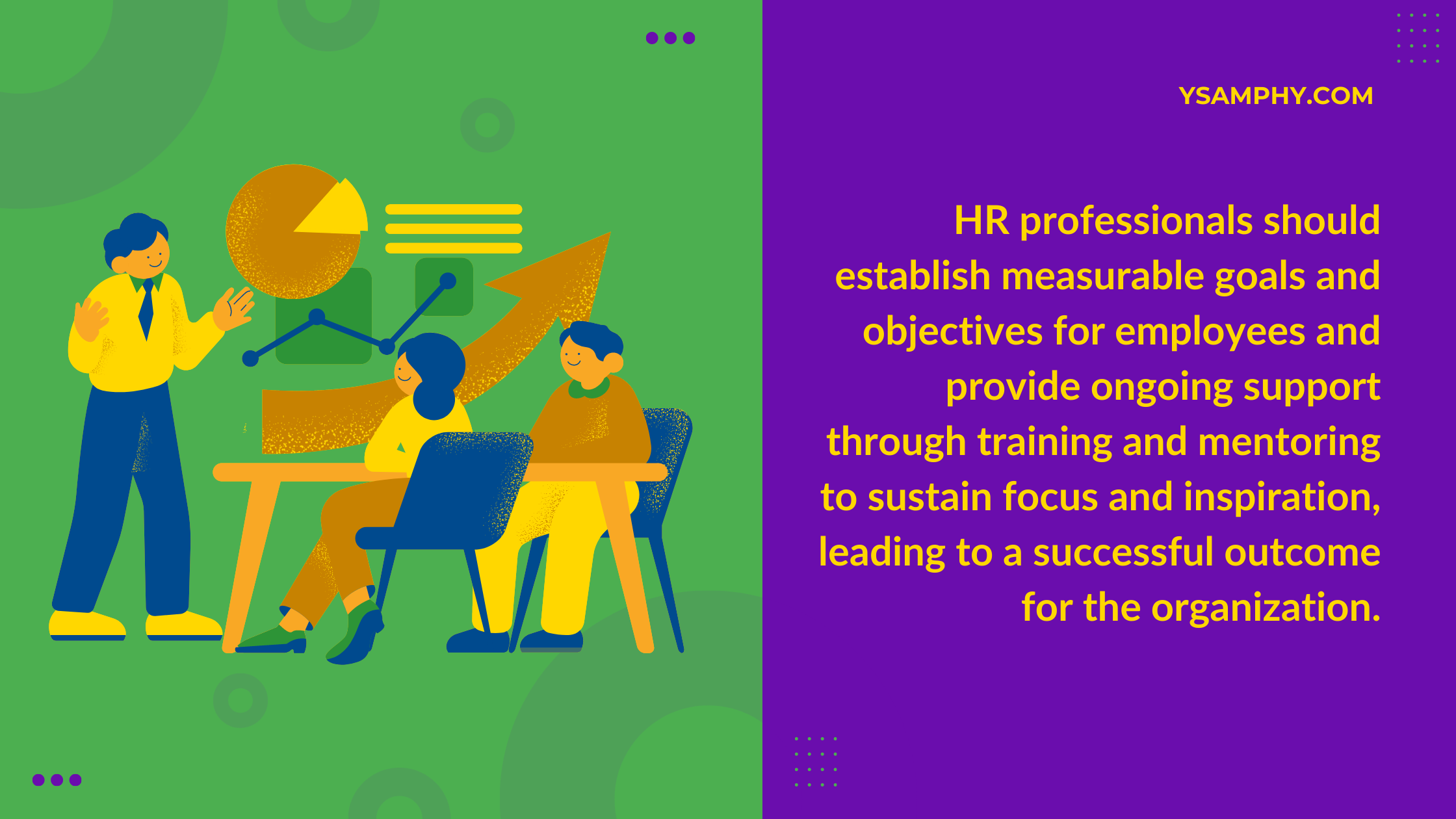
HR plays a critical role in setting clear goals and objectives for employees to ensure they work towards the same end goal. It is necessary that these objectives are quantifiable, feasible, and consistent with the firm's overall plan.
Identifying what needs to be accomplished is the starting point for achieving successful objectives and aims. This can include specific performance targets or milestones that must be reached within a certain timeframe. Once identified, creating detailed plans outlining how these goals will be accomplished is important.
It’s also important for HR professionals to provide ongoing support and resources so that employees have the tools they need to reach their targets on time. This could include access to training programs, mentoring opportunities, or additional materials such as books or online courses. Having this type of support available can help keep employees motivated and focused on reaching their individual goals while contributing positively to the team’s success.
Setting forth definite aims and ambitions is necessary for enhancing productivity, providing a focus for employees to strive towards particular objectives. By providing training and development opportunities, HR can help ensure that employees have the necessary skills and knowledge to achieve those goals.
Key Takeaway
HR professionals should create measurable goals and objectives to ensure employees work towards the same end goal, then provide ongoing support such as training programs or mentoring opportunities. Providing continual aid, such as training and mentoring, will help sustain focus and inspiration to ensure a prosperous result for the organization.
Provide Training and Development Opportunities

Providing employees with training and development opportunities is essential for equipping them with the skills necessary to be successful. HR can play a major role in providing these opportunities for their staff and helping them take advantage of them. HR can assist personnel in developing their abilities by providing formal instruction, on-the-job training, and guidance initiatives.
Formal training programs allow employees to learn new skills or refresh existing ones in an organized setting with structured materials. This program is especially beneficial when introducing new technology or processes into the workplace. Formal training can ensure that all personnel have a uniform understanding of the proper procedures to be followed within the company.
Under the guidance of experienced colleagues, on-the-job training enables employees to gain hands-on experience in their respective fields. This type of learning is particularly useful when mastering complex tasks such as software programming or customer service techniques that require practice over time before mastery is achieved. Mentoring programs pair junior staff members with senior colleagues who share their knowledge and expertise so that less experienced workers can gain insights into best practices without going through trial and error themselves.
Offering training and development chances can assist workers in acquiring the capacities they need to be fruitful, helping them become more connected with their work. Giving workers the necessary resources and backing can further boost their productivity by granting them access to the essential tools they need and training them on how to use their device for success.
Key Takeaway
Offering training and development initiatives, like formal courses, on-the-job teaching, and mentorship plans, can substantially boost employee efficiency. This will equip staff with the necessary skills to excel in their roles, help them get up to speed quickly when introducing new technology or processes into the workplace and provide a valuable source of knowledge from experienced colleagues.
Provide Resources and Support
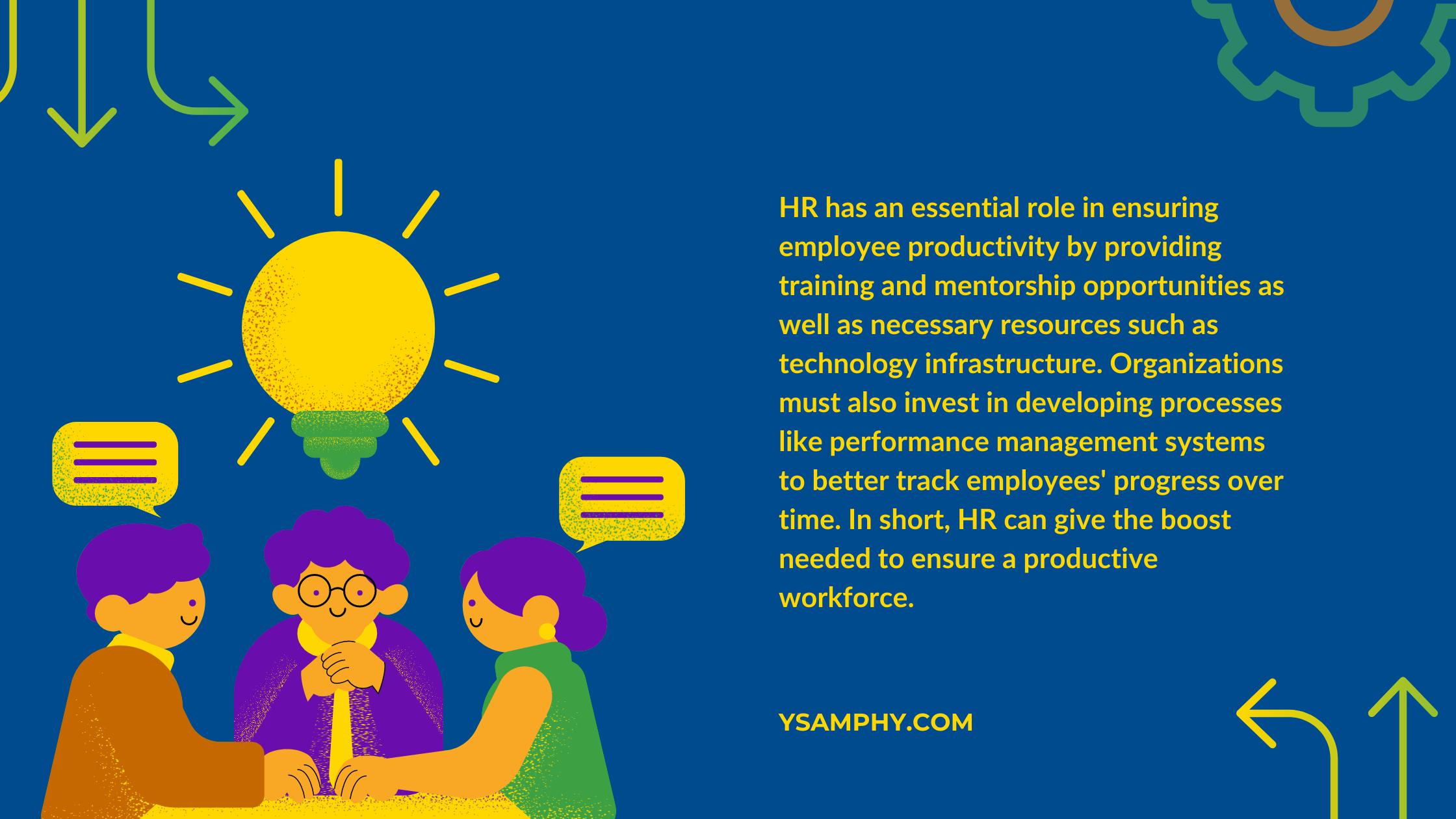
HR is critical in furnishing personnel with the supplies and aid they need to be productive. HR personnel must recognize that their fundamental duty is to provide workers with the instruments, instruction, and chances for the progress they need to succeed.
Training is essential for a successful productivity strategy; HR should thus equip employees with continual learning opportunities to sharpen their abilities and keep abreast of the latest industry advancements. HR should provide employees with ongoing training opportunities that help them develop new skills and stay current on industry trends. Mentoring can be advantageous, as it furnishes personnel with the chance to draw on the expertise of seasoned professionals who can give insight into how best to utilize their capabilities in a particular context. Coaching sessions are another great way for HR departments to help workers hone their abilities and maximize their potential.
Supporting employee growth doesn't stop at just providing training materials or offering mentorship programs; it's also important for HR departments to make sure that all necessary resources are available when needed. This includes having adequate technology infrastructure, ensuring enough staff on hand during peak periods, and ensuring everyone has access to the latest software updates or other tools required by job roles. Additionally, organizations should invest in developing processes such as performance management systems to enable managers and supervisors to better track employee progress and adjust objectives accordingly if needed.
Offering aid and assistance to staff is a key component of any HR plan. Supplying aid and backing to personnel is fundamental for any HR approach, enabling them to be more productive, proficient, and triumphant in their jobs. Monitoring progress helps ensure that the resources are used effectively and efficiently to meet goals on time.
Key Takeaway
HR has an essential role in ensuring employee productivity by providing training and mentorship opportunities as well as necessary resources such as technology infrastructure. Organizations must also invest in developing processes like performance management systems to better track employees' progress over time. In short, HR can give the boost needed to ensure a productive workforce.
Monitor Progress
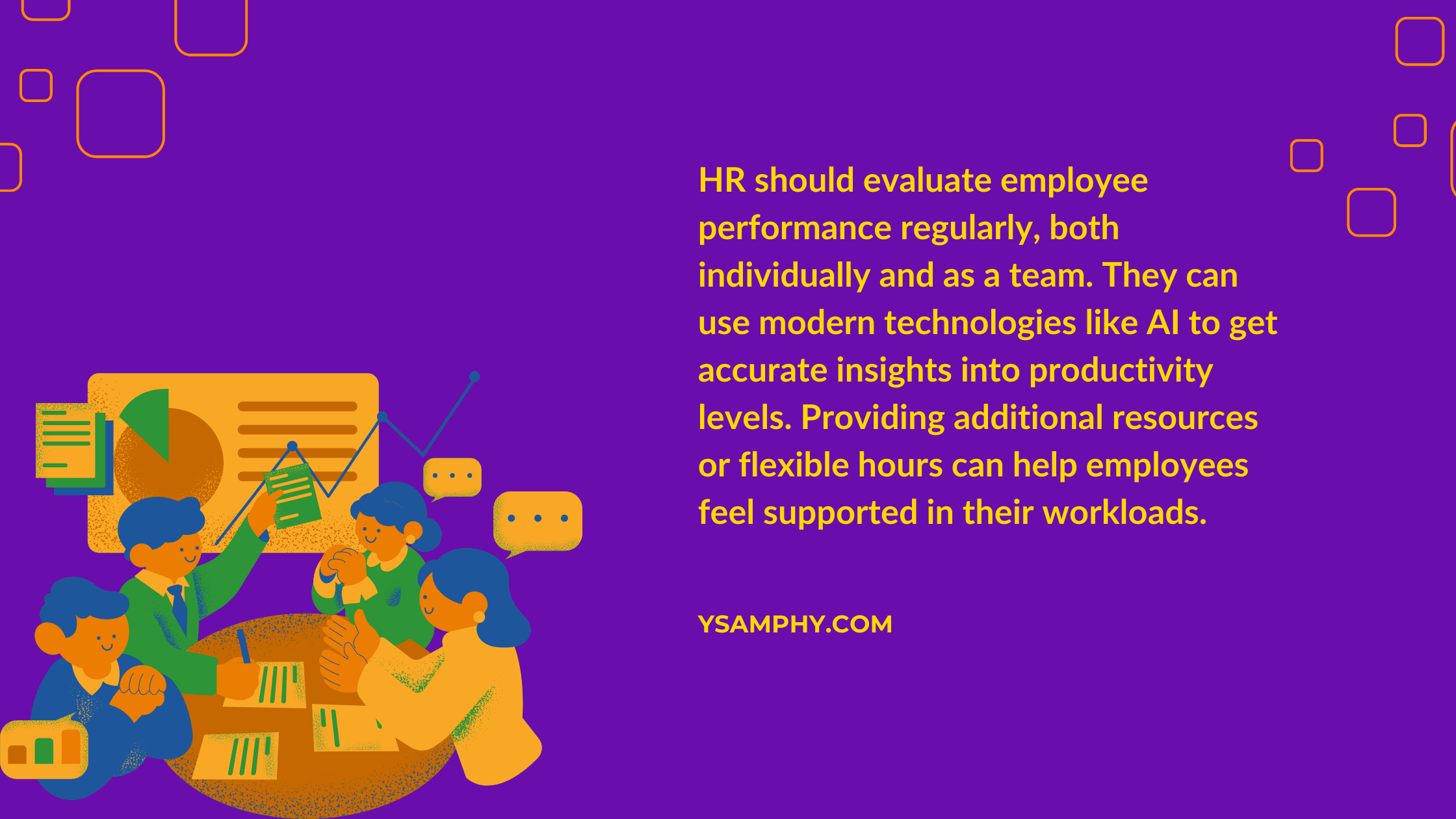
Employee performance monitoring is an important part of maintaining a productive workplace. HR should regularly assess employees’ progress toward their goals and objectives to ensure they meet expectations. Regular feedback sessions or performance reviews can measure progress, provide constructive criticism, and identify areas for improvement.
When assessing performance, evaluating individual and collective achievement indicators is essential. Individual metrics include attendance, punctuality, quality of work output, customer service ratings, etc., while team-level metrics might involve looking at the overall efficiency of a department or the success rate of projects completed by a group. By tracking both data points over time, HR can gain insight into which strategies are working best and which need adjustment or refinement.
In addition to measuring employee performance through traditional methods such as surveys or interviews with managers and colleagues, modern technologies like artificial intelligence (AI) can also be utilized for more accurate insights into productivity levels across departments. AI algorithms can analyze large amounts of data quickly in order to detect patterns that may indicate potential issues with workflow processes or suggest new ways for teams to collaborate more effectively.
HR should ensure staff feel backed up when their workloads abruptly increase due to outside causes such as seasonal demand shifts or unforeseen alterations in corporate policy. Providing additional resources where needed—such as extra staff members during peak periods—can help reduce stress levels among workers while ensuring that tasks get done on time without sacrificing quality standards. Similarly, offering flexible hours or remote work options whenever possible helps create an environment where employees feel empowered rather than overwhelmed by their responsibilities.
Tracking advancement is essential for optimizing efficiency, as it enables alterations and enhancements to be made to attain sought-after outcomes. Creating a motivating atmosphere is critical for maximizing efficiency, as it energizes staff to take ownership of their duties and carry them out with excitement.
Key Takeaway
HR should regularly assess employee performance metrics individually and as a team. Modern technologies like AI can be utilized to gain accurate insights into productivity levels across departments. Providing additional resources or flexible hours when needed will help ensure employees feel supported in their workloads.
Create a Positive Work Environment
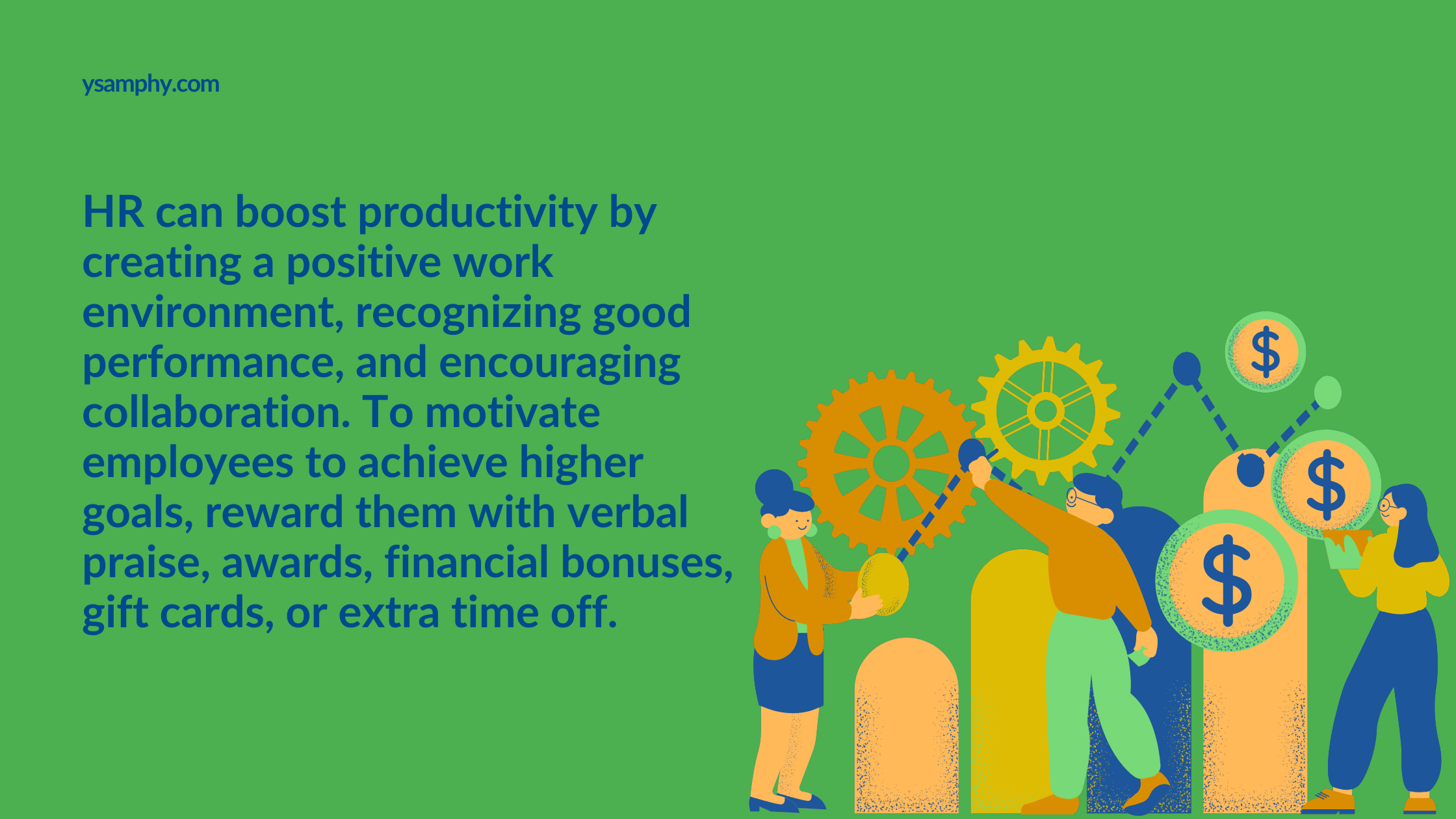
Creating a positive work environment is essential for increasing productivity. HR professionals should aim to create an environment where staff members feel respected and inspired to achieve their highest potential. Recognizing good performance, providing incentives for high achievers, and encouraging collaboration are key components of creating a productive workplace.
Recognition can come in many forms, such as verbal praise or awards. It’s important that employees receive recognition for their hard work and accomplishments so they feel appreciated and encouraged to continue striving toward success. Additionally, it’s beneficial to provide rewards such as bonuses or additional vacation days when appropriate; this will help motivate employees to reach higher goals while showing them that their efforts are appreciated.
Incentives can be used in addition to recognition to motivate employees who have already achieved success or exceeded expectations. These could include financial bonuses, gift cards, extra time off, etc., depending on the company's budget and available resources. Incentives show employees that the organization values them and wants them to succeed by rewarding those who go above and beyond with something tangible other than just words of appreciation.
Creating a positive work environment is essential to encouraging productivity and employee satisfaction. By fostering an atmosphere of innovation, employers can further promote creativity and collaboration in the workplace.
Key Takeaway
HR professionals can improve productivity by creating a positive work environment, recognizing good performance, providing incentives for high achievers, and encouraging collaboration. To motivate employees to reach higher goals, reward them with verbal praise or awards and financial bonuses, gift cards, or extra time off.
Encourage Innovation
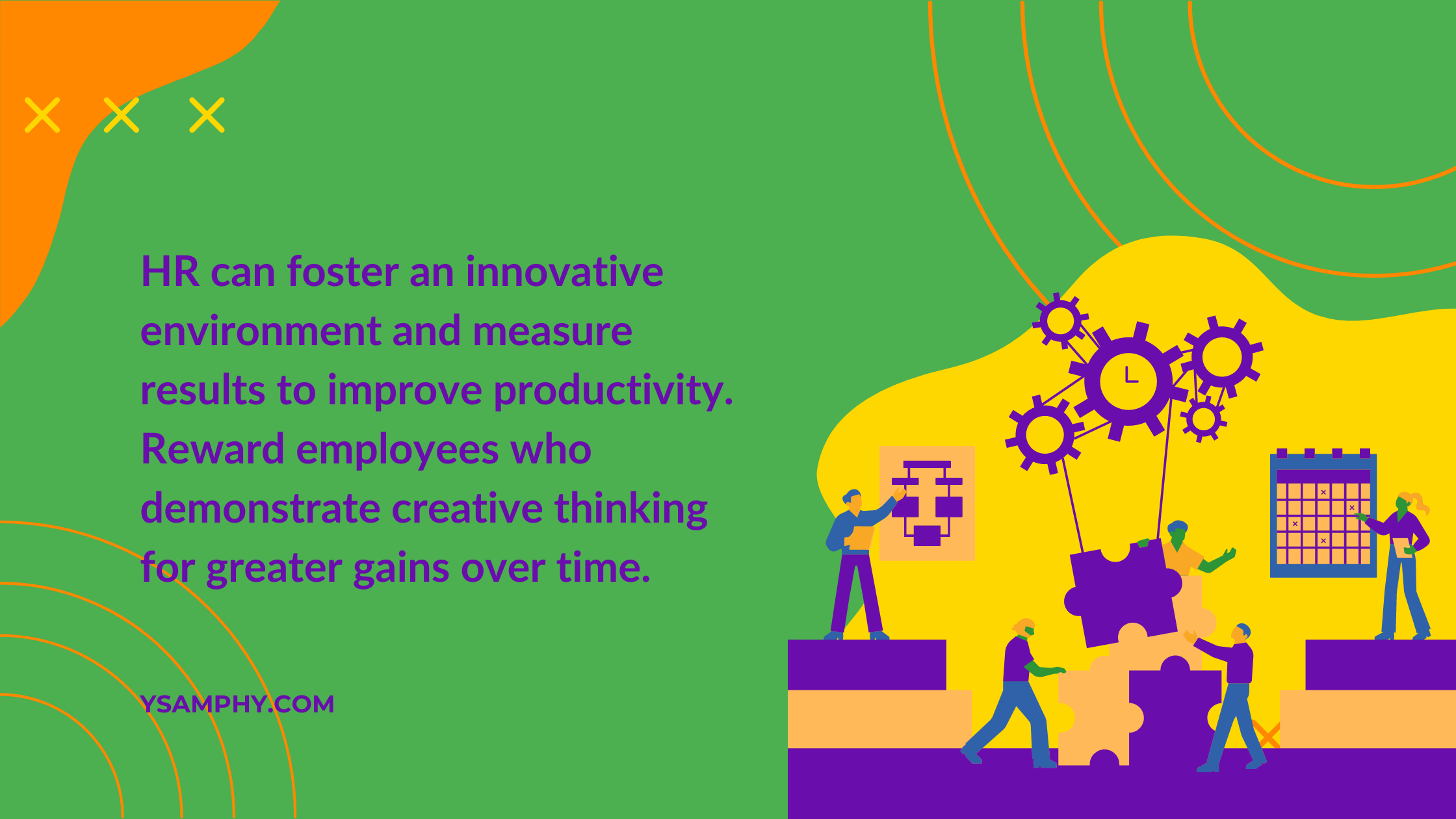
Innovation is key to improving productivity in the workplace. HR pros can cultivate a milieu of creativity by allowing staff to investigate novel concepts and take risks without dreading reprimands from leadership. This encourages creativity, leading to more innovative solutions to improve efficiency and performance.
HR should furnish employees with training, guidance schemes, and access to field specialists in order for them to have the means required for success. HR should also create a positive work environment where collaboration and risk-taking are encouraged. This will help build trust among team members and promote open communication between departments.
HR should also measure results to identify improvement areas and recognize successes when they occur. For example, if an employee has come up with a creative solution that improves productivity or reduces costs, then it’s important for them to be recognized for their efforts so others are motivated by their success story.
Finally, HR must reward employees who demonstrate innovative thinking in order to encourage future innovations within the organization. Monetary rewards are one way of doing this, but recognition from peers or managers can also be beneficial. By creating incentives for innovative thinking through recognition systems such as these, organizations can foster an environment where creativity flourishes – ultimately leading to greater overall productivity gains over time.
Fostering creativity in the work setting can result in heightened efficiency and ingenuity. Measuring results is essential for tracking progress and identifying areas that need improvement.
HR can foster an innovative environment and measure results to improve productivity. Reward employees who demonstrate creative thinking for greater gains over time. #ProductivityGains #InnovationMatters
Measure Results
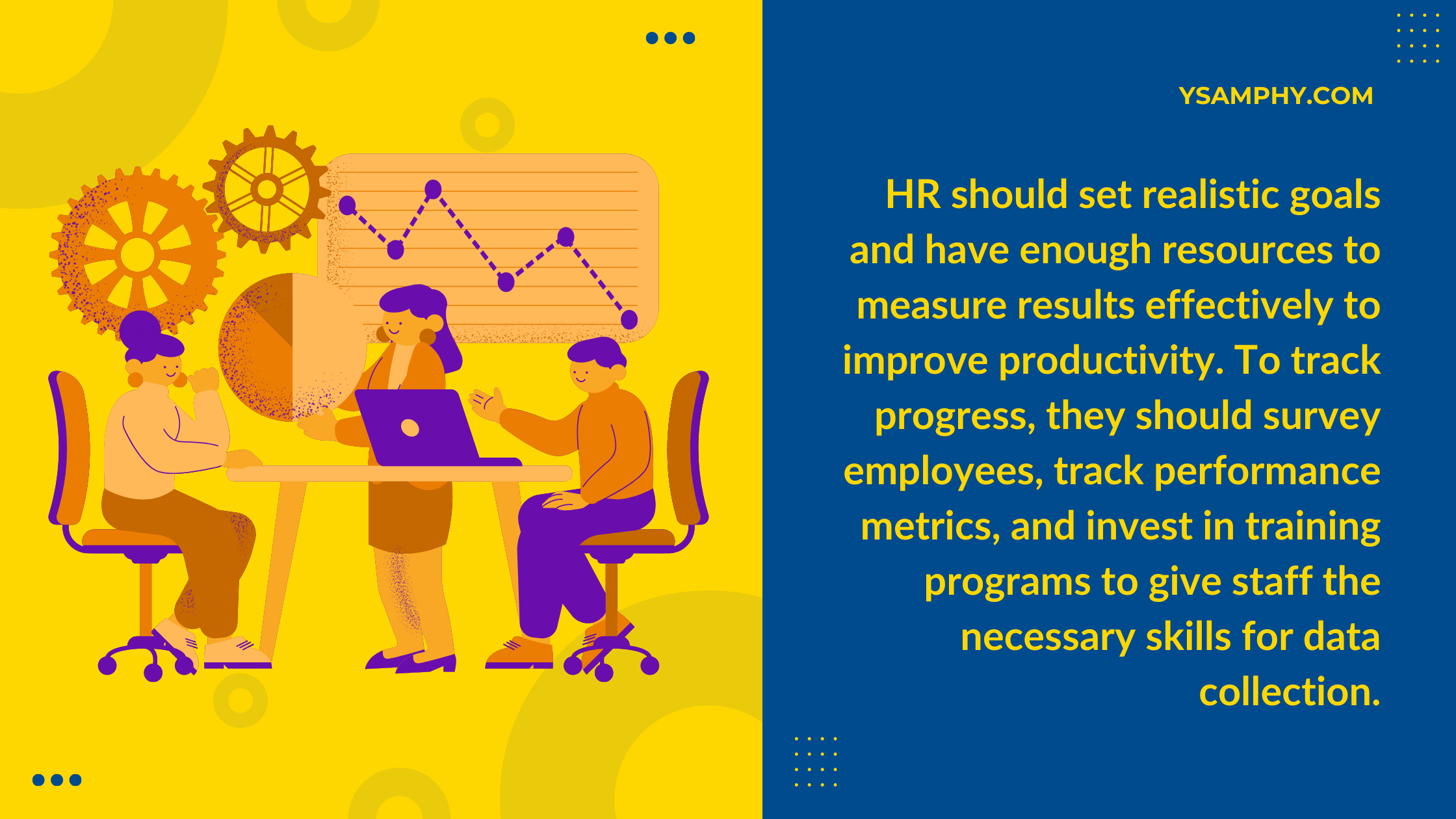
Measuring the results of an HR team’s efforts to improve productivity is essential for determining whether their initiatives have a positive impact. Gathering responses from staff through questionnaires, conversations, and other types of input can help assess the effectiveness of HR initiatives. Additionally, measuring performance metrics such as employee engagement, retention rates, absenteeism levels, and output can provide valuable insights into how well HR strategies work.
HR should strive to set realistic objectives that account for the multifaceted nature of organizational dynamics. If, despite their best efforts, an organization falls short of its goal to boost productivity by 10% within a year due to outside forces such as market fluctuations or personnel changes – this should not be viewed as HR's downfall but instead, offer them a chance to tweak their tactics accordingly.
HR teams should also ensure they have adequate resources available in order to measure results effectively. This could include software tools for tracking time and progress towards goals or access to data that can help inform decisions about which initiatives will be most effective in achieving desired outcomes. Additionally, investing in training programs so that staff members have the necessary skillset required for gathering and analyzing data is also important when measuring results accurately over time.
Tracking success and pinpointing areas needing more work are integral components of any endeavor to increase productivity, making it possible to observe progress. By recognizing and rewarding employees who have succeeded in improving their productivity, organizations can create a culture that encourages continued growth.
Key Takeaway
HR teams should set realistic goals and have adequate resources to measure results effectively in order to improve productivity. To better gauge their progress, they should survey employees, track performance metrics such as employee engagement and output levels, and invest in training programs that give staff members the necessary skillset for gathering data.
Recognize and Reward Employees
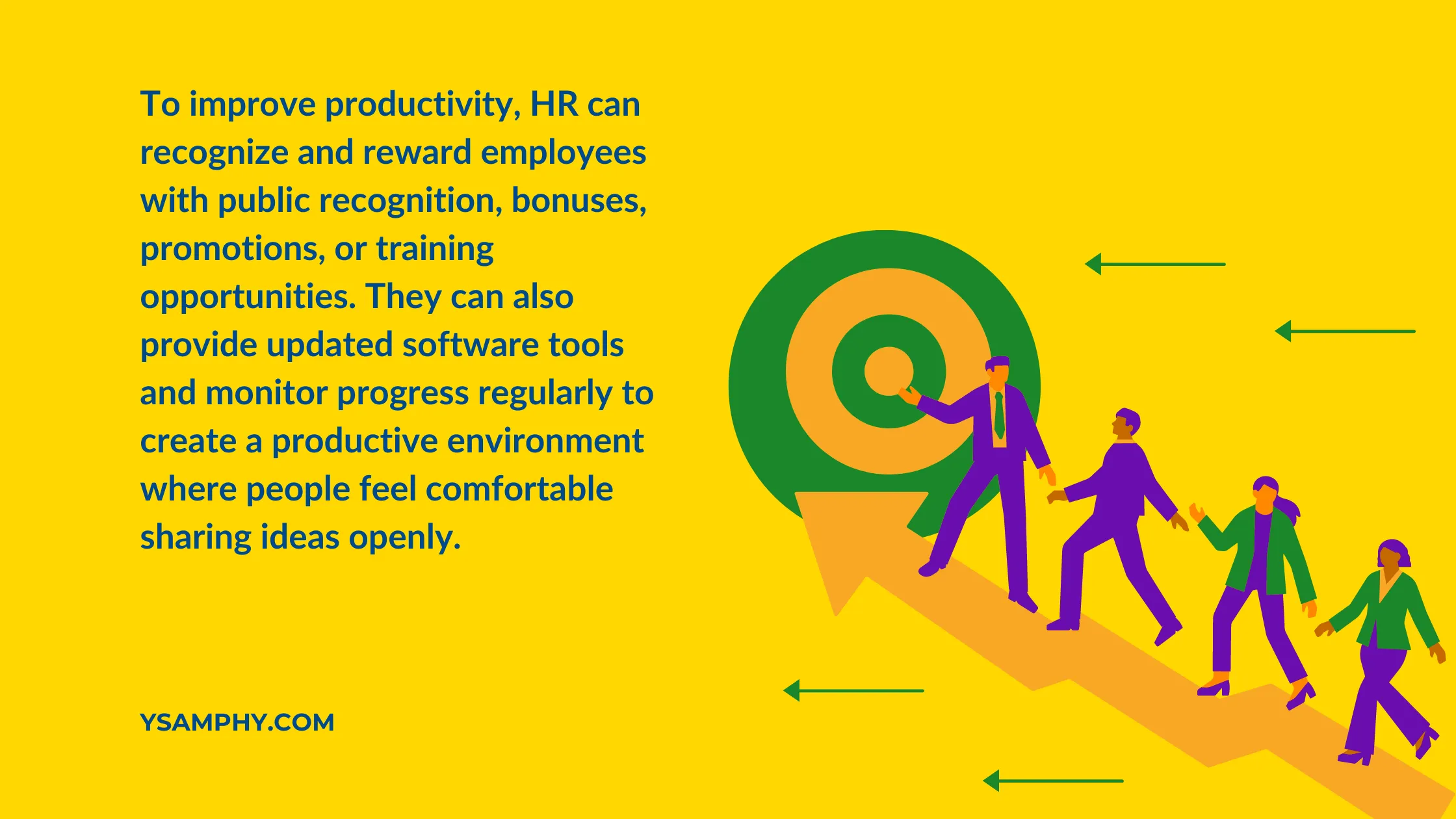
Acknowledging and compensating staff for their efforts has been demonstrated to boost productivity. HR can recognize and reward employees in various ways, from public recognition to bonuses and promotions. Public recognition is an effective way to show appreciation for the hard work of individual employees or teams. This could include announcements at staff meetings, awards ceremonies, or other public events where employees can receive praise for their achievements. Both monetary and non-monetary bonuses can be a powerful motivators for employees to reach their full potential. Promotions also serve as an incentive for employees by offering them greater responsibility within the organization and higher salaries.
By offering employees tailored training opportunities that match their individual needs, employers can provide access to resources to help them become more productive in the workplace. These training sessions should be tailored specifically towards each individual employee’s needs so they can get the most out of it while still being able to apply what they learned back on the job. Providing additional resources, such as updated software tools, books, online courses, etc., can also help increase productivity levels among workers since they have access to better technology that allows them to do their jobs faster and more efficiently than before.
Monitoring progress is key when it comes to keeping track of how well your team is doing with regard to productivity goals set forth by management. Regular check-ins with supervisors or managers will allow you to gauge whether or not those goals are being met so adjustments can be made, if necessary, accordingly, without disrupting workflow too much to keep everyone focused on getting things done quickly but effectively at all times. Creating a positive work environment is just as important because having an atmosphere where people feel comfortable sharing ideas openly encourages creativity which leads to innovation which helps drive up efficiency across multiple departments within any given organization
Key Takeaway
HR can improve productivity by recognizing and rewarding employees with public recognition, bonuses, promotions, or training opportunities. Additionally, providing resources such as updated software tools and monitoring progress regularly will help create a productive environment where people are comfortable sharing ideas openly.
FAQs about How Can HR Improve Productivity

HR can improve productivity by creating a positive work environment, focusing on employee development and training, providing clear goals and expectations for employees, implementing effective performance management systems, recognizing and rewarding good performance, fostering collaboration among team members, and promoting an open communication culture between managers and staff. Additionally, HR should ensure that employees have the resources they need to do their jobs efficiently while monitoring workloads to prevent burnout.
HR can contribute to productivity management by creating an environment that encourages employees to be productive. This includes setting clear expectations, providing feedback and support, establishing rewards for meeting goals, and recognizing achievements. HR should also ensure all policies are in place to support productive work, such as flexible working hours or remote work options. HR should also focus on employee engagement initiatives like team building activities or regular check-ins with staff members to help keep morale high and increase productivity levels.
Human Resources (HR) plays an integral role in production by ensuring that the right people are hired and retained, providing training and development opportunities to increase their skill set, creating a safe working environment, managing employee relations issues, administering benefits programs, developing policies and procedures for workplace safety compliance. Additionally, HR can support management with research on best practices in productivity initiatives and provide feedback from employees regarding processes or tools that could be improved upon. HR works to ensure that the organization is able to reach its output objectives in a proficient and successful manner.
Conclusion
The role of HR in improving productivity is essential. By hiring the right people, establishing clear goals and objectives, providing resources and support, monitoring progress, creating a positive work environment that encourages innovation as well as measuring results, and recognizing employee efforts can hr improve productivity significantly. Businesses must acknowledge the importance of HR in improving productivity and take steps to ensure they are capitalizing on their employees' capabilities.
Take proactive steps to ensure your HR practices foster a productive work environment. Invest in training and development programs, promote open communication channels, and provide clear employee expectations to help improve productivity.

